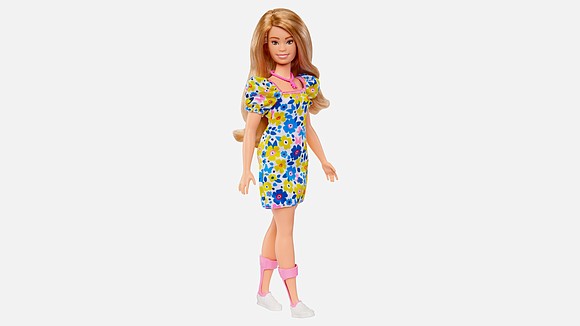Mattel introduces first Barbie doll representing a person with Down syndrome
CNN/Stylemagazine.com Newswire | 4/25/2023, 9:32 a.m.

Originally Published: 25 APR 23 08:54 ET
Updated: 25 APR 23 09:23 ET
By Parija Kavilanz, CNN
(CNN) -- Mattel on Tuesday introduced its first-ever version of the Barbie doll representing a person with Down syndrome.
The new doll is part of Mattel Barbie Fashionistas line, which aims to offer kids more diverse representations of beauty and fight the stigma around physical disabilities.
Previous Barbie Fashionistas have included a doll with a prosthetic leg, one with hearing aids, another that comes with a wheelchair and a doll with the skin condition vitiligo, which causes patches of skin to lose their pigment.
For the newest Barbie Fashionista, Mattel said it closely worked with the National Down Syndrome Society on the doll's shape, features, clothing, accessory and packaging to ensure that it accurately represents a person with Down syndrome. The genetic condition affects cognitive ability, causing mild to severe learning disabilities and distinctive facial characteristics.
"This means so much for our community, who for the first time, can play with a Barbie doll that looks like them," Kandi Pickard, NDSS president and CEO said in a statement. "This Barbie serves as a reminder that we should never underestimate the power of representation. It is a huge step forward for inclusion and a moment that we are celebrating."
Mattel recently has embraced a more inclusive approach to its 64-year-old iconic Barbie brand. But the company has long faced criticism for giving girls a role model of a female body type with unrealistic proportions.
For decades after its debut in 1959, Barbie dolls continued to be light-skinned -- white -- slender, blonde, with a very narrow waist, ample bosom and always teetering on impossibly high heels.
Finally, in 2016, as it faced softening sales of the doll, Mattel crafted Barbie into a more realistic depiction by making the newer dolls more inclusive and diverse in their appearance. Barbie was reintroduced in four body types and seven skin tones, with 22 eye colors and 24 hairstyles. Her evolution continues with Barbie Fashionistas, which came three years later.
The newest Fashionista doll, which Mattel said was reviewed by a medical professional, introduces a new face and body sculpt illustrative of women with Down syndrome, including a shorter frame and a longer torso. The face features a rounder shape, smaller ears, a flat nasal bridge, while the eyes are slightly slanted in an almond shape.
Its palms include a single line, a characteristic often associated with those with Down syndrome, according to Mattel.
The new Barbie wears a pink ankle foot orthotics to match her dress and her sneakers feature a zipper to represent children with Down syndrome, some of whom use orthotics to support their feet and ankles.
Mattel said the new Barbie's puff sleeved dress pattern features butterflies and yellow and blue colors, which are symbols and colors associated with Down syndrome awareness.
And the doll's pink pendant necklace with three upward chevrons, a symbol that unites the Down syndrome community, represents the three copies of the 21st chromosome which is the genetic material that causes the characteristics associated with Down syndrome.
"Our goal is to enable all children to see themselves in Barbie, while also encouraging children to play with dolls who do not look like themselves," Lisa McKnight, Mattel's executive vice president and global head of barbie & dolls, said in a statement.
McKnight said Mattel's goal with the doll is to "counter social stigma through play."
"Doll play outside of a child's own lived experience can teach understanding and build a greater sense of empathy.... We are proud to introduce a Barbie doll with Down syndrome to better reflect the world around us and further our commitment to celebrating inclusion through play," she said.



